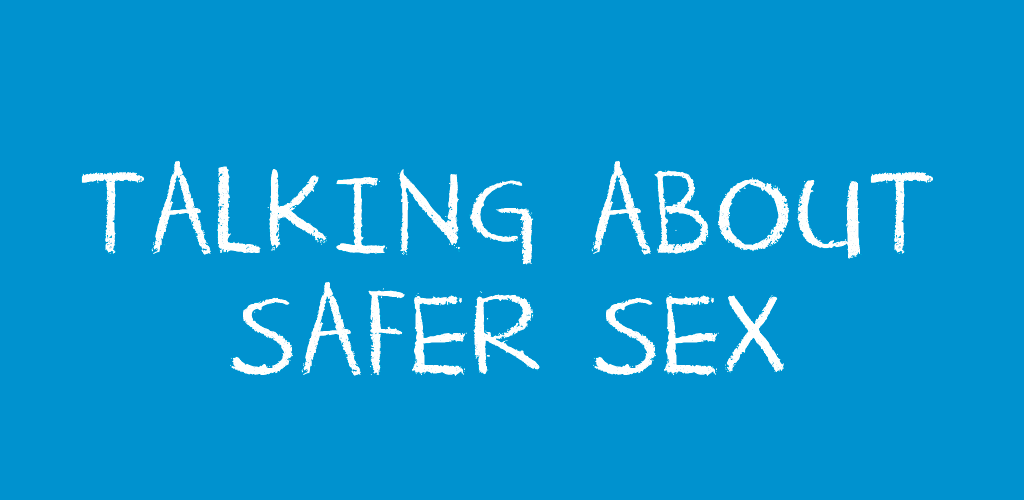Talking About Safer Sex
Talking about safer sex can be tricky no matter who you are. However, in order to reduce your risk of getting a sexually transmitted infection (STI) and/or having an unplanned pregnancy, practicing safer sex is important. Don’t rely on your partner(s) to tell you that they have an STI or to use birth control. Everyone is responsible for their own sexual health.
This page can help you prepare for and talk to your partner about safer sex. For more information on STIs and how to protect yourself, see the STI Section [Link] of this website.
What is safer sex?
- Sex can be fun and pleasurable but it can come with risks such as sexually transmitted infections (STIs) and/or unplanned pregnancy. Safer sex is about taking care of yourself and your partner(s).
- Safer sex includes:
- Talking to your partner(s) before having sex about using safer sex tools such as condoms, dams and gloves to prevent the exchange of blood, semen (cum), vaginal and anal fluids that can transmit an STI or cause an unplanned pregnancy.
- Asking your partner(s) before having sex if they have an STI or if they have ever been tested for STIs.
- Getting tested for STIs when you or your partner has a new sexual partner. If you have new sexual partners often, get STI testing every 3-6 months. If you ever have symptoms of an STI, get tested right away.
- Consider sexual activities that can’t result in an unplanned pregnancy or that put you at lower risk of getting an STI (such as finger play or oral sex).
- Consider getting the vaccines that are available for preventing Hepatitis B and some strains of HPV.
What makes talking about safer sex so hard?
- You may fear your partner will make fun of you, put you down, call your names or refuse to have sex with you.
- You may be having sex with someone you just met or don’t want to talk to about safer sex.
- You may think that having a safer sex conversation will feel like a “downer.”
- Your partner may assume they are not at risk of getting an STI. In reality, anyone of any gender, sexual orientation, race, class or occupation can get an STI. Hormonal birth control methods like the pill do not protect you from STIs.
- You or your partner may be unsure how to use condoms, dams or gloves.
- You may be drinking or using drugs.
- If you are experiencing violence in your relationship, you may not feel that you have the ability to request safer sex.
It can be difficult, but having an open and honest conversation with your partner is the best way to take care of your sexual health and reduce your risk. You may find that when you do bring it up, your partner has been wanting to talk about it too.
Get talking
The way you start a conversation about safer sex will depend on the person and what you know about them. Here are some tips:
- Think about what you’re going to say in advance. Do some research ahead of time so you know what boundaries and safer sex practices you are asking for.
- If you’ve talked about uncomfortable topics with this partner before, what worked? What didn’t work? Use what you know about the person you are talking to.
- Pick a moment when you have enough time and privacy to talk. Also choose a time when you are in a positive mood and your partner is too – nothing defeats good communication like feeling too tired, having a bad day or feeling rushed.
- If you don’t know the person you are about to have sex with, have safer sex tools handy, put them out and say something that feels comfortable but clear like, “I’m ready, are you?”
- Communicate your feelings about safer sex in a clear, honest and positive manner to ensure there are no misunderstandings. Use “I” statements to talk about how you feel and what you want, rather than what you think your partner feels or wants.
- While humour can ease awkwardness, avoid teasing or joking about it.
- If you feel like you can’t be direct, you could try something like, “What do you think about condoms?” or mention an article you read on safer sex to get the conversation started.
- Talking about any kind of sex, including safer sex, can bring up people’s insecurities and fears and lead to a negative reaction. If this happens, try not to be defensive or make accusations. Acknowledge the other person’s feelings, correct any misunderstandings and offer the person time to think about it.
- Sometimes people have a negative reaction based on past experiences, misinformation or fear. Having outside information ready, such as pamphlets from reliable sexual health sources, can help bust myths and provide accurate facts. This can be particularly helpful if you have an STI and plan to tell a partner.
- Remind your partner that safer sex doesn’t mean sex has to be less pleasurable. Suggest some of the tips listed below under “Making safer sex sexy.”
- Come to a clear agreement about what safer sex practices you are going to use. This could include using condoms, getting tested for STIs, having one partner or using safer sex tools when having sex with other people.
- Appreciate your partner for talking about safer sex with you.
- It is your right to be safe and your partner(s) should respect your request for safer sex. If your partner still disagrees with you about safer sex or tries to pressure you to have sex without the protection you have requested, think about whether they are someone you still want to have sex with.
Making safer sex sexy
It can be easy to back down from a safer sex agreement when you’re in the moment. Try to have safer sex tools handy. With a little creativity and playfulness, safer sex can be really sexy. Here are some suggestions:
- Experiment with different colours, textures and types of condoms, dams or gloves and make trying a new kind fun.
- Try putting a condom on yourself (or a dildo or banana) when you are on your own to get some practice. The more familiar you are with safer sex tools, the easier it will be to use them.
- If you have a penis*, masturbate with a condom on to train your brain to associate pleasure and orgasm with a condom.
- Make gloves, dams and condoms part of your sex play. Talk dirty while you’re putting a condom, dam or glove on. Go slowly and tease the other person by making them wait. Experiment with latex clothing or role playing.
- Put a condom on your partner with your hands or mouth.
- Put lube into the tip of an external condom before putting it on the penis or put lube inside the internal condom before putting it inside a vagina* or anus. Add lube to the vulva/vagina or anus and/or the outside of an external condom.
Remember
- Don’t rely on your partners to tell you that they have an STI or to use birth control. Everyone is responsible for their own sexual health.
- See the Safer Sex page for more information on safer sex tools [Link].
| Useful Tips |
|
For a downloadable resource on this topic, please visit Planned Parenthood Toronto Factsheet Database.
If you have questions about this topic, feel free to contact one of our peer educators. [Link]
*We know that these aren’t the words everyone uses for their bodies (eg. trans folks), and support you using the language that feels best for you.
Last Edited: May 2020






